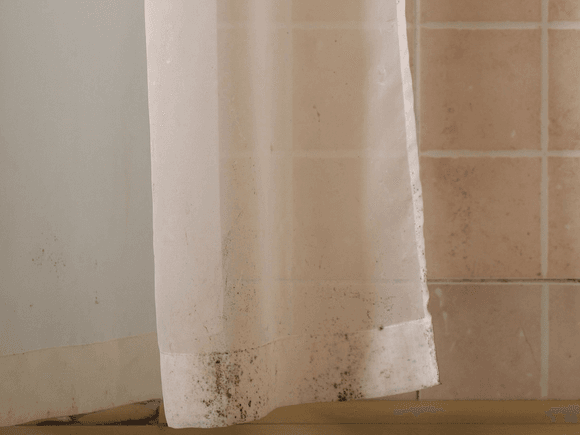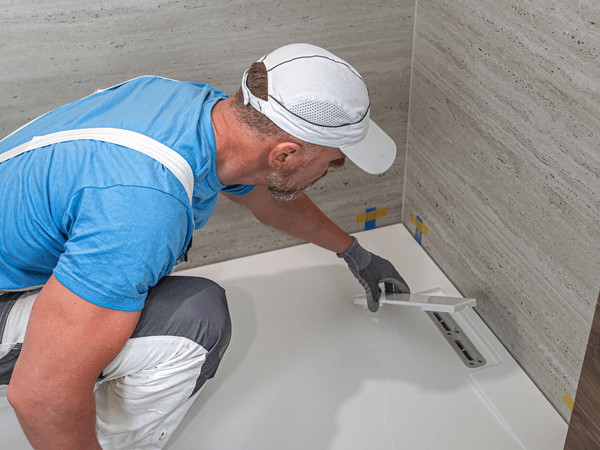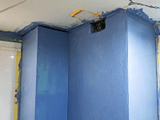How To Get Mould Off A Shower Curtain
How to remove mould from shower curtains using natural vinegar solutions, chemical treatments, and prevention strategies for different climates.

Discovering mould creeping across your shower curtain is every homeowner’s nightmare. Research shows shower curtains harbour up to 60 times more germs than toilet seats, a significant health concern hiding in your daily routine. In Australian homes, where humidity levels soar during increasingly wet summers, this problem grows more prevalent each year.
That black, green, or pink growth isn’t just unsightly—it’s potentially harmful to your family’s health, particularly for children, elderly relatives, and anyone with respiratory conditions. The good news? Learning how to get mould off a shower curtain effectively can restore both your bathroom’s hygiene and your peace of mind.
You’ll discover proven methods for removing mould from every type of shower curtain, from natural eco-friendly solutions to more intensive chemical treatments. Learn prevention strategies tailored to Australia’s unique climate challenges, understand when cleaning makes sense versus replacement, and gain the confidence to tackle this common household problem head-on.
Understanding why shower curtains attract mould
The Australian climate factor
Australia’s diverse climate presents unique challenges for bathroom maintenance. Our tropical north experiences year-round humidity that creates perfect breeding conditions for mould, while southern regions face their own humidity spikes during hot summers and condensation issues in cooler months. Climate change has intensified these patterns, with many areas experiencing more rainfall and higher humidity levels than previous decades.
When you combine these environmental factors with the reality that most Australian homes rely on natural ventilation rather than mechanical systems, you’ve got a recipe for mould problems. Modern energy-efficient building practices, while beneficial for sustainability, often reduce airflow and trap moisture inside homes.
Perfect conditions for growth
Understanding how to get mould off a shower curtain starts with recognising why it grows there in the first place. Mould requires three key ingredients: moisture, warmth, and organic matter to feed on. Your bathroom shower area provides all three in abundance.
During a typical shower, bathroom humidity can spike above 70 percent, with temperatures reaching the mid-20s. These are ideal conditions for mould growth. The organic matter comes from soap scum, dead skin cells, and dust that accumulate on curtain surfaces. This combination creates what experts call prime real estate for mould colonisation.
Timeline of mould development
Under optimal conditions, mould spores begin growing within 24-48 hours of landing on wet surfaces. Visible colonies develop within one week, and extensive growth occurs within one month if left unchecked.
This rapid timeline explains why regular maintenance and prompt action are crucial for keeping your shower curtain mould-free.
Common mould types in Australian bathrooms
Several types of mould commonly appear on shower curtains in Australian homes:
Black mould (Stachybotrys chartarum) appears as dark green or black patches and can produce mycotoxins that pose serious health risks with prolonged exposure.
Aspergillus presents in various colours and is particularly common in humid bathroom environments.
Pink bacteria (Serratia marcescens) technically isn’t mould but creates similar slimy growth, often appearing as pink or orange patches.
Each type requires slightly different treatment approaches, though the fundamental cleaning principles remain consistent.
Safety precautions before you begin
Before removing mould from your shower curtain, gather proper safety equipment. Mould spores become airborne during cleaning and can trigger allergic reactions, asthma attacks, or respiratory issues.
Required protective gear:
- Rubber gloves to protect skin
- P1 or P2 face mask to prevent spore inhalation
- Safety glasses to shield eyes from splashes
- Old clothes you can wash immediately after
For extensive mould coverage, invest in a proper respirator for maximum protection.
Ventilation requirements
Proper airflow during cleaning is absolutely vital. Open all available windows and doors to create cross-ventilation. Turn on exhaust fans and leave them running throughout the cleaning process and for at least 30 minutes afterward.
If your bathroom lacks adequate ventilation, set up a portable fan to blow air toward an open window or door. Never attempt mould removal in an enclosed, poorly ventilated space.
When to call professionals
Some situations warrant professional intervention rather than DIY efforts. If mould covers more than 10 percent of your shower curtain, or if you have underlying health conditions like asthma, COPD, or a compromised immune system, contact a professional cleaning service or mould remediation specialist.
Pregnant women should also avoid direct mould cleaning due to potential health risks to both mother and baby.
Know your curtain materials
Fabric curtains
Cotton, polyester, hemp, and other fabric curtains offer aesthetic appeal and environmental benefits but require more careful handling when addressing mould issues. These materials are more porous than plastic alternatives, meaning mould can penetrate deeper into the fibres.
Fabric curtains generally respond well to machine washing with appropriate additives, but always check care labels first. Some decorative curtains may require dry cleaning or have specific temperature requirements that affect your treatment options.
Vinyl and PVC options
Traditional vinyl and PVC shower curtains are water-resistant and easy to clean, but they can off-gas chemicals and may become brittle over time. These materials typically handle stronger cleaning solutions well but can be damaged by excessive heat or harsh scrubbing.
The smooth surface of vinyl makes it easier to remove surface mould, but creases and folds can trap moisture and create persistent problem areas.
PEVA and EVA alternatives
PEVA (polyethylene vinyl acetate) and EVA (ethylene vinyl acetate) represent safer plastic alternatives that don’t contain harmful chlorine compounds. These materials resist mould growth better than traditional fabrics while avoiding the chemical concerns associated with PVC.
PEVA and EVA curtains typically respond well to both natural and chemical cleaning methods and can withstand regular washing without degradation.
Natural cleaning methods
White vinegar solution: Mix four parts vinegar to one part water, or use undiluted for stubborn spots. Spray affected areas and wait 15-20 minutes before scrubbing. Vinegar’s acid breaks down mould structures and prevents regrowth.
Baking soda paste: Mix three parts baking soda with one part water to create a thick paste. Apply with a soft brush using circular motions, then wait 10-15 minutes before rinsing. This method works excellently on fabric curtains where harsh chemicals aren’t suitable.
Hydrogen peroxide treatment: Mix two parts hydrogen peroxide with one part water, or use undiluted for severe cases. The solution will bubble and foam on contact—this reaction shows it’s working. Wait 10-15 minutes, scrub gently, then rinse completely.
Tea tree oil enhancement: Add 5-10 drops of tea tree oil to your vinegar or hydrogen peroxide solution for boosted antifungal effectiveness. This natural approach leaves a fresh scent while providing extra mould-fighting power.
Chemical solutions for stubborn mould
Oxygen bleach alternative
Oxygen bleach (sodium percarbonate) provides powerful mould-killing action without the harsh fumes and toxic residue of chlorine bleach. It breaks down into water and oxygen, making it environmentally safer while still delivering effective results.
Mix according to package directions (typically one tablespoon per cup of warm water) and apply to mouldy areas. Allow 15-30 minutes contact time before scrubbing and rinsing.
Borax treatment
Borax, a naturally occurring mineral, offers excellent antifungal properties while being less harsh than synthetic chemicals. Create a solution using one cup of borax per gallon of water for soaking treatments, or make a paste for localised application.
Always wear gloves when handling borax, as it can cause skin irritation. This method works particularly well for vinyl and plastic curtains that can withstand stronger solutions.
Commercial mould killers
Australian hardware stores stock various commercial mould removal products designed specifically for bathroom use. Look for products that list their active ingredients and avoid those with excessive harsh chemicals if you have family members with sensitivities.
Apply according to manufacturer directions, ensuring adequate ventilation throughout the process.
Step-by-step cleaning methods
Method 1 for machine washing fabric curtains
Step 1 Preparation (5-10 minutes) Remove all rings, hooks, or hardware. Pre-treat mouldy areas with your chosen solution and wait 15-30 minutes for contact time.
Step 2 Washing cycle (45-60 minutes)
Use cold water on gentle cycle with regular detergent. Add one cup white vinegar to the rinse cycle. Include clean towels to prevent bunching.
Step 3 Drying (6-12 hours) Never use the dryer as heat damages materials and sets stains. Hang curtain on rod while damp and allow air circulation to complete drying.
Method 2 for hand cleaning all materials
Setup (5 minutes) Work in your bathtub or outdoors if weather permits. This contains any dripping solutions and provides easy access to running water.
Application (10 minutes) Lay the curtain flat and spray your chosen cleaning solution evenly across affected areas. Pay special attention to bottom edges and fold lines.
Contact time (15-30 minutes): Allow solutions to work without letting them dry completely on the surface.
Scrubbing (10-15 minutes): Use a soft-bristled brush with circular motions and moderate pressure to avoid material damage.
Rinsing (5-10 minutes): Rinse thoroughly with clean water, ensuring all cleaning solution residue is removed.
Method 3 for soaking treatment in severe cases
Solution preparation: For extensive mould coverage, prepare enough solution to completely submerge the curtain in your bathtub. Use undiluted vinegar or two tablespoons of oxygen bleach per gallon of water.
Soaking duration: Allow 1-4 hours for moderate mould growth, extending to 6-8 hours for severe cases. Check periodically to monitor progress.
Post-soak cleaning: After soaking, scrub remaining mould patches manually before final rinsing. The extended contact time should have loosened most growth.
Prevention strategies
Daily habits that prevent mould
After every shower (30 seconds):
- Separate curtain from liner so both can air dry
- Spread curtain fully across rod, eliminating folds
- Wipe away water droplets with a clean towel
- Leave bathroom door slightly open for air circulation
Ventilation routine:
- Run exhaust fan during showers and 20-30 minutes after
- Crack window during bathing if available
- Create cross-ventilation by leaving door ajar after use
Humidity control strategies
Maintain bathroom humidity levels between 35-50 percent to discourage mould growth. In naturally humid areas like Queensland’s coast or during Melbourne’s humid summer days, this may require additional intervention.
Portable dehumidifiers designed for bathroom use can effectively remove excess moisture from the air. Position them away from direct water exposure but within the bathroom space for maximum effectiveness.
Weekly and monthly maintenance
Weekly routine (5 minutes): Spray curtains with a light vinegar solution and wipe down with a clean cloth. This removes soap residue and skin cells that serve as mould food sources.
Monthly deep cleaning: Machine wash fabric curtains or hand clean plastic options using your preferred method from the techniques described above. Use this opportunity to inspect curtain hardware and check for bathroom issues like poor ventilation or plumbing leaks.
Australian regional considerations
Regional climate challenges
Australia’s diverse climate creates unique bathroom challenges requiring tailored approaches. In tropical Darwin or Cairns, year-round humidity means daily vigilance and residents often need monthly rather than seasonal cleaning cycles. During the wet season, even well-ventilated bathrooms struggle with moisture control.
Southern cities face different patterns. Melbourne’s summer humidity spikes can catch homeowners off-guard, especially during February heatwaves when bathroom ventilation becomes crucial. Adelaide residents notice winter condensation issues requiring careful moisture management during cold mornings.
Perth’s Mediterranean climate offers seasonal advantages. Wet winters demand increased vigilance, while dry summers provide excellent natural drying conditions for deep cleaning projects.
Seasonal adjustment strategies
Adapt your mould prevention strategies to Australia’s seasonal patterns. During humid summer months, increase ventilation efforts and run dehumidifiers more frequently. The extended daylight hours provide excellent opportunities for natural drying.
Winter brings different challenges, particularly in southern regions where cold mornings create condensation on bathroom surfaces. Maintain heating in bathrooms when possible and ensure ventilation continues even in cooler weather.
When to replace versus clean
Quick replacement decision checklist
Replace immediately if:
- Mould covers more than 10% of curtain surface (imagine your curtain in 10 sections—mould in 2+ sections = replace)
- Musty odours persist after thorough cleaning
- Material shows cracks, thinning, or rough patches
- Family members have respiratory conditions or allergies
Clean instead if:
- Mould appears in small, isolated patches
- Curtain is less than 6 months old
- No underlying health concerns in household
- First occurrence after proper cleaning routine
Cost comparison
Australian families can effectively control shower curtain mould using common household items. A monthly investment of under $10 in vinegar, baking soda, and basic cleaning supplies can maintain multiple curtains year-round.
Compare this to replacement costs—quality shower curtains range from $20-100, making prevention clearly more economical than frequent replacement.
Troubleshooting common problems
Persistent odours
Sometimes odours linger even after visible mould removal. This usually indicates incomplete cleaning or mould growth in hidden areas like fold lines or attachment points.
Address stubborn odours by soaking the entire curtain in a strong vinegar solution overnight, followed by thorough rinsing and careful drying. Baking soda can also help neutralise remaining odours—dust it over damp curtains and brush off after an hour.
Rapid regrowth
If mould returns quickly after cleaning, investigate underlying causes rather than simply repeating the cleaning process. Check for bathroom leaks, inadequate ventilation, or environmental factors contributing to excessive humidity.
Sometimes rapid regrowth indicates incomplete initial cleaning—increase contact time for cleaning solutions and ensure thorough coverage of all affected areas.
Taking action for a healthier bathroom
Learning how to get mould off a shower curtain successfully means understanding that prevention beats cure every time. The simple daily habits outlined above, spending 30 seconds post-shower positioning your curtain correctly and running ventilation for 20 minutes, prevent far more problems than they solve.
Start today by assessing your current curtain condition. If you spot early mould growth, act immediately using the natural cleaning methods described. Remember that Australian conditions, from Darwin’s year-round humidity to Melbourne’s summer spikes, require consistent attention to bathroom moisture control.
Every family’s needs differ. Households with young children, elderly residents, or family members with respiratory conditions may need more frequent cleaning schedules and earlier replacement decisions. Your family’s health always trumps economic concerns.
The cleaning techniques above provide everything needed to address shower curtain mould at any stage. With consistent prevention habits and prompt attention to early signs, you can maintain a healthier bathroom environment while avoiding the frustration and expense of recurring mould problems.
Don’t wait for the problem to worsen. Examine your shower curtain today and implement the appropriate prevention strategies for your household situation.
Frequently Asked Questions
How often should I clean my shower curtain to prevent mould?
Can I use bleach on all types of shower curtains?
What are the early signs that my shower curtain needs replacing rather than cleaning?
Are natural cleaning methods as effective as chemical ones for removing mould?
How do I prevent mould from returning after cleaning my shower curtain?
This article provides general information only and should not be considered professional advice. Building regulations and standards are subject to change. Always consult licensed building practitioners and relevant authorities for advice specific to your project. Information is current as of publication date and accuracy cannot be guaranteed.



